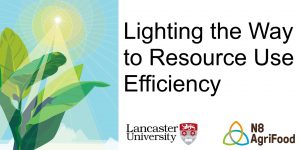
Academics, business people and students, from as far away as London and Middlesbrough, gathered at the Lancaster Environment Centre (LEC) on the afternoon of the 6th February 2019 for the N8 Agrifood-sponsored workshop Lighting the Way to Resource Use Efficiency, which showcased different technologies for manipulating the light environment which crops are exposed to. International visitors from Pennsylvania State University (USA) and Cukurova University (Turkey) were able to join the meeting via video-conference. The workshop was held as part of an N8 Local Pump-Priming Award made by Lancaster University, to foster collaboration with the University of Liverpool and Stockbridge Technology Centre (Yorkshire).
Following a brief introduction by host Professor Ian Dodd (LEC), Professor Nigel Paul (LEC) provided a historical perspective on light manipulation in cropping systems, with projections into the future. Drawing on his archives of previous research, he convinced the audience of his ability to accurately predict the future use of light-emitting diodes (LEDs) in protected horticulture (give or take 5 years). A highlight was his video of “aphids dancing” in response to UV exposure.
Dr Miguel de Lucas Torres (Durham) providing a fascinating insight into the molecular mechanisms by which plants perceive lighting cues, with changes in gene expression orchestrated by transcription factors and nuclear chromatin modification. Dr Rhydian Beynon-Davies (Stockbridge) showcased results from some of the unique lighting facilities at his site, demonstrating that light’s influence extends below-ground, with substantial modification of rooting patterns (and transplant success) when seedlings are exposed to light regimes of different spectral quality.
Dr Kathleen Demchak (Pennsylvania) reported the initial results of the TunnelBerries project, which uses different plastic claddings to manipulate the light environment berry crops are exposed to. In addition to effects on crop yields and quality, certain claddings reduced the levels of some insect pests to manageable levels in the absence of pesticide applications. Dr Wagdy Sobeih (Arid Agritech) also discussed his company’s ambitions to develop new plastic claddings to best suit specific crops, based on a wealth of experience in commercial protected horticulture in the Middle East, where increasing crop water use efficiency is a priority for growers.
Following enthusiastic discussion at the coffee break (with cakes the colour of some of the light regimes previously discussed !), the audience reconvened for the Practising Photobiologists session, allowing Lancaster-registered research students to briefly present their work:
Tom Williams outlined his research on UV effects on leaf gas exchange of tomato crops
Phoebe Sutton discussed her work with MayBarn Consultancy on developing bespoke lighting regimes for high value herbs
Hao Zhou presented his measurements of crop yield, gas exchange and volatile emissions, collected during his research placement at Stockbridge last summer, while a student at the University of York.
Several discussion points were considered in the closing remarks, with informal discussions suggesting sufficient interest in a follow-up meeting in Durham next year. Malcolm Yare (Current, powered by GE) commented “This is a great opportunity for technology manufacturers to connect and learn from academia whom have the foremost information and techniques of plant growth. The networking and knowledge transfer is paramount to providing new and innovative horticultural LED lighting solutions that growers seek to provide a competitive edge”
While resource use efficiency may be only one aspect that growers consider when developing horticultural cropping systems, it became apparent they could have their cake and eat it too – with increased yields, decreased costs and increased resource use efficiency all achievable following sufficient research.